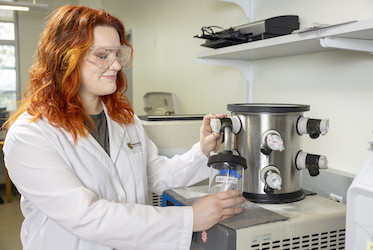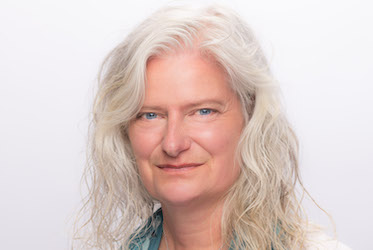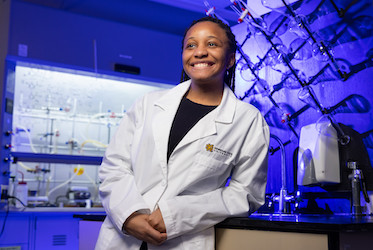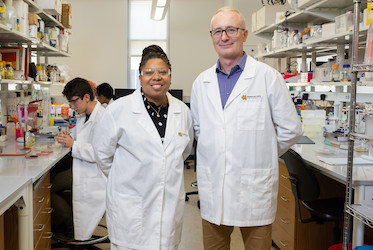
Planet Earth
KENNESAW, Ga. | Apr 22, 2019
Environmental science professor tackles Fukushima nuclear disaster
Preserving the planet for future generations sometimes involves doing some dirty work, like cleaning up a huge radioactive nightmare lingering on the northeastern coast of Japan.
Eight years ago, the Fukushima Daiichi Nuclear Power Plant experienced a catastrophic meltdown caused by an earthquake and tsunami. When a hydrogen explosion rocked the plant’s Unit 3 reactor, on March 14, 2011, radioactive iodine and cesium spewed into the atmosphere. Much of that pollution fell on farmland in the Iitate Village, forever disrupting the livelihoods of the families residing within the 88-square-mile area.
Daniel Ferreira, an assistant professor of environmental science at Kennesaw State, said he believes he has developed a method to cleanse the contaminated soil.
“Of all the contaminants that affected the soils in this area,” Ferreira said, “radiocesium is one of the most serious because it decays very slowly and will likely continue to emit radiation for at least 300 years. Before tragedy struck, this was a highly productive agricultural area. The farmers made a living selling rice and other crops grown from their nutrient-rich soil.”

In the aftermath of the meltdown, the Japanese government removed the contaminated topsoil and stockpiled it in Osaki, about 120 kilometers north of Fukushima. After a mandatory five-year evacuation period, the farmers returned to fields that had had their nutrient-rich topsoil removed and replaced with a sterile, mineral-rich fill material made by grinding up rocks from the nearby mountains.
But it’s the dilemma of what to do with the approximately 9 million bags of contaminated soil that has captured Ferreira’s attention.
“I’m working with Dr. Bharat Baruah from our Department of Chemistry and Biochemistry to find a chemical extraction method that could cleanse the contaminated soil,” Ferreira said.
Ferreira visited Iitate Village in 2016 and 2017 to meet with farmers who live in the region and other scientists doing research there.
“Unfortunately, Japan’s temporary solution is still in place,” Ferreira said of the stockpiles. “That’s because no one has yet come up with a viable long-term solution for what to do with that contaminated soil. Clearly, this seriously hampers their ability to farm the land.”

Ferreira said this might not be a problem in other fallout locations, as cesium is usually very water soluble. That means it can quickly move downwards through the soil until it disperses into the groundwater. This dilutes the radioactivity and moves it out of the area.
“However, the soils in the northeastern region of Japan, including Iitate Village, are rich in a particular kind of clay mineral called vermiculite, which presents a challenge,” he said. “My research shows the radiocesium is tightly bound to the soil, which contains a significant amount of clay – like so much of Georgia’s own soil. That means it remains trapped very close to the surface of the soil, so its radiation can more easily impact people and wildlife in the region than if the soil had less clay.”
Traditional ways of getting heavy metals out of the soil aren’t effective because of the intense chemical bond formed between the vermiculite minerals and the cesium, he explained. Ferreira and Baruah are working on a way to overcome that bond and remove the cesium from the soil so that it can be disposed of more easily or even re-used.
“So far, the preliminary data suggest that the method I developed with my graduate student during our research trip to Japan in 2017 is capable of removing the radiocesium from the clay in Fukushima soil, which is a big step forward toward finding a solution,” Ferreira said.

Ferreira is planning to return to Japan with interested students for a two-week education abroad program next summer. Part of the curriculum will include learning about the impacts of the disaster and meeting with some of the farmers in Iitate Village who hope someone can cleanse the area’s contaminated soil for the next generation.
– Robert S. Godlewski
Photos provided by Daniel Ferreira
Related Stories
A leader in innovative teaching and learning, Kennesaw State University offers undergraduate, graduate and doctoral degrees to its more than 45,000 students. Kennesaw State is a member of the University System of Georgia with 11 academic colleges. The university’s vibrant campus culture, diverse population, strong global ties and entrepreneurial spirit draw students from throughout the country and the world. Kennesaw State is a Carnegie-designated doctoral research institution (R2), placing it among an elite group of only 7 percent of U.S. colleges and universities with an R1 or R2 status. For more information, visit kennesaw.edu.



















